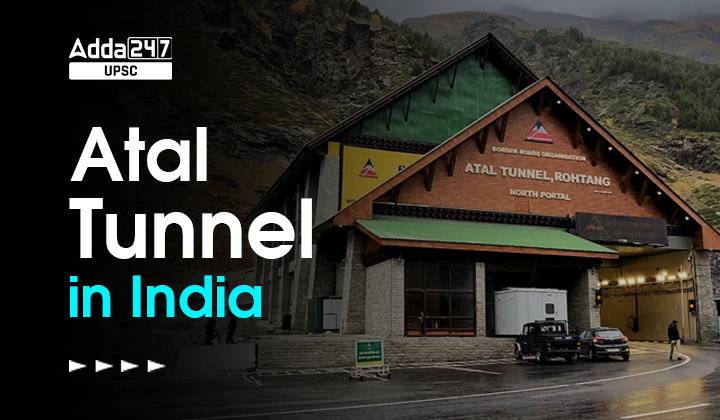Table of Contents
Atal Tunnel in India also known as Rohtang Tunnel is a 9.02-kilometer-long roadway tunnel situated beneath the Pir Panjal range in Himachal Pradesh, India. Atal Tunnel has been officially recognized as the ‘Longest Highway Tunnel above 10,000 feet’ by the World Book of Records. The tunnel’s elevation of 3,100 meters (10,171 feet) above sea level makes it one of the highest road tunnels in the world. In this article, you will know about the history, construction, and significance of the Atal Tunnel.
The Legacy of Atal Bihari Vajpayee
The tunnel is named after the former Prime Minister of India, Atal Bihari Vajpayee, who initiated the project in 2002 and is considered to be one of his most significant legacies. The tunnel connects Manali in the Kullu Valley to Lahaul-Spiti Valley, a remote region of Himachal Pradesh that remains cut off from the rest of the country for most of the year due to heavy snowfall and landslides. The construction of the Atal Tunnel is a remarkable feat of engineering and has been hailed as a game-changer for the region, as it has reduced the travel time between Manali and Lahaul-Spiti from 5-6 hours to just 30 minutes.
Features of the Atal Tunnel
The Atal Tunnel is an engineering marvel that boasts several impressive features. For one, it is the longest highway tunnel in the world at a length of 9.02 km. The tunnel is also located at an altitude of 3,000 meters above sea level, making it one of the highest road tunnels in the world. To ensure safety and convenience, the tunnel has been designed with a state-of-the-art ventilation system that provides fresh air and removes pollutants. Additionally, the tunnel is equipped with an advanced firefighting system and emergency telephones every 150 meters. The Atal Tunnel is not just a game-changer for road connectivity in the Himalayas, but also a testament to the engineering prowess of India.
Manali to Atal Tunnel (Atal Tunnel ki kul Lambai)
Prior to the construction of the Atal Tunnel, the only way to reach Lahaul-Spiti from Manali was to drive over the Rohtang Pass, which could take hours or even days in unfavorable weather conditions. However, with the opening of the Atal Tunnel, the travel time has been reduced significantly. The distance from Manali to the south portal of the tunnel is around 25 km, and it takes approximately 30 minutes to cover this stretch. The Atal Tunnel has thus not only connected Manali to Lahaul-Spiti but also made the journey faster and safer for locals and tourists alike.
Challenges in Atal tunnel Construction
Northern India’s Himalayan mountain range is home to the Atal Tunnel, often referred to as the Rohtang Tunnel, which is a highway tunnel. In addition to reducing the distance between the two locations by about 46 kilometers, it was built to enable all weather communication between Manali and Leh. Many difficulties were encountered during the Atal Tunnel’s construction, including. Here you can check some difficulties encountered during the Atal Tunnel’s construction.
- Geological challenges: The tunnel passes through the Pir Panjal range, which is a geologically unstable region in India. The area is prone to landslides, rockfalls, and earthquakes, which made the Atal Tunnel construction process more challenging.
- High altitude: The tunnel is located at an altitude of 3,000 meters (10,000 feet) above sea level. Due to high altitude several challenges, including extreme weather conditions, low oxygen levels, and difficult terrain. Workers had to acclimatize themselves to the altitude before they could start working.
- Harsh weather conditions: The tunnel is located in a region that experiences heavy snowfall, especially during the winter. The construction process had to be halted several winter months due to heavy snowfall, which delayed the project.
- Logistic challenges: The remote location of the Atal tunnel made it difficult to transport construction materials, machinerys, and equipment. The project required the construction of a new road and the installation of a ropeway to transport materials to the construction site.
- Technical challenges- The construction of the Atal tunnel required the use of advanced boring machines, which had to be imported from other countries. The machines had to be customized to suit the geological conditions of the hills.
Interesting facts about the Atal Tunnel for UPSC Aspirants
- The Atal Tunnel is the longest highway tunnel in the world at an altitude of over 3,000 meters (10,000 feet) above sea level.
- The tunnel is named after former Indian Prime Minister Atal Bihari Vajpayee, who initiated the project in 2002.
- The Atal Tunnel is located in the Pir Panjal range of the Himalayas and connects Manali in Himachal Pradesh to Leh in Ladakh.
- The tunnel was constructed by the Border Roads Organisation (BRO), a wing of the Indian Army.
- The construction of the Atal Tunnel started in 2010 and was completed in 2020, taking approximately 10 years to complete.
- The tunnel is approximately 9.02 km long and is designed to withstand heavy snowfall, landslides, and earthquakes.
- The tunnel has reduced the distance between Manali and Leh by approximately 46 km, and travel time by approximately 4 to 5 hours.
- The tunnel has been constructed with several safety features, including an automatic incident detection system, a ventilation system, and a firefighting system.



 TSPSC Group 1 Question Paper 2024, Downl...
TSPSC Group 1 Question Paper 2024, Downl...
 TSPSC Group 1 Answer key 2024 Out, Downl...
TSPSC Group 1 Answer key 2024 Out, Downl...
 UPSC Prelims 2024 Question Paper, Downlo...
UPSC Prelims 2024 Question Paper, Downlo...





